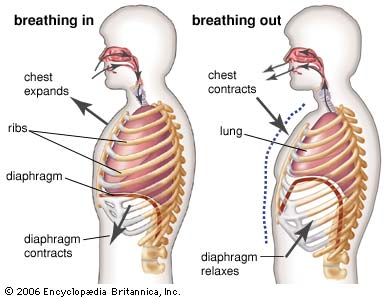Breath: The Forgotten Strength
After reading some of the great posts by guys like Eric Cressey, Mike Boyle and some other amazing health professionals, I’ve started spending more time looking at how some mid, upper and even lower back injuries could be influenced by how a person breathes. To think about it , it makes sense as the ribs and associated muscles make up a large area of the spine, and a lot of movements are required to do proper deep breathing. The main three are the elevation and expansion of the ribs, and the depression of the diaphragm into the abdominal cavity.
All these moving parts have the ability to break down once in a while, and just like with any other part of the body, it can create imbalances and an increased amount of stress on other areas. Let’s look at some of the common areas of dysfunction.
1. Diaphramatic breathing
Many people with short and tight rectus muscles will tend to have difficulty allowing their abdomen to stretch to accompany a descending diaphragm, which would limit the ability of that muscle to move. This would result in having the upper lungs (thoracic spine and scalenes) to do all the work, and would end up causing some discomfort in the neck above the collar bone and between the shoulder blades during hard cardio. With prolonged dysfunction, it can mean a reduction in stability of the intercostal muscles and an increase in pressure form the rhomboids and trapezius to pick up the stability slack. In short, upper takes up lower.
2. Lower rib breathing
By not allowing the lower ribs to expand properly and accept air into the lower lungs in conjunction with the diaphragm will again increase load on the thoracic spine and upper ribs. Similar dysfunctional patterns as the diaphragmatic breathing.
3. Upper rib breathing
This is common with people who slouch or who have a kyphotic posture that limits the expansion of the ribs forward and up. By default, these people have to breathe with nothing but their diaphragm, which will cause a reduction in muscle contraction strength of the core, as these muscles have to relax to allow breathing to occur. This will commonly result in a “side stitch” from the diaphragm and internal obliques becoming hypoxic from overuse.
Self tests
So since you are all now wondering what the hell I’m talking about, let’s do a little self-test to figure out how you breathe. There will be three components here, so you will have to check each one individually.
1. Belly breath
Put your hand on your stomach, just above your belly button, sit up tall, and take a deep breath. See if your stomach presses out. If it does, congratulations because you can actually breathe with your diaphragm!!!
2. Lower rib breath
Put your hands on your sides, just above your hips, sit tall and take a deep breath. If you feel your lower ribs press out, congratulations because you breathe with your lower ribs!!! Are both sides equal?? More often they won’t be, as we all have a dominant hand, and as such will hold that side tighter. If one side moves and the other doesn’t we might have some work to do.
3. Sternal/upper rib breathing
Put your hand high on your sternum, sit tall, and take a deep breath, checking to see if your sternum rises and moves slightly forward. If it does, congratulations because you can actually breathe with your upper ribs!!
Now let’s say you have some difficulty with these breathing patterns and want a few ways to increase your ability to breathe properly and restore your normal breathing rhythm. That will be something for part two, so stay tuned for some fun and excitingly riveting information on how to breathe!!! And you thought you figured it all out with the “in, out” rhythm.
